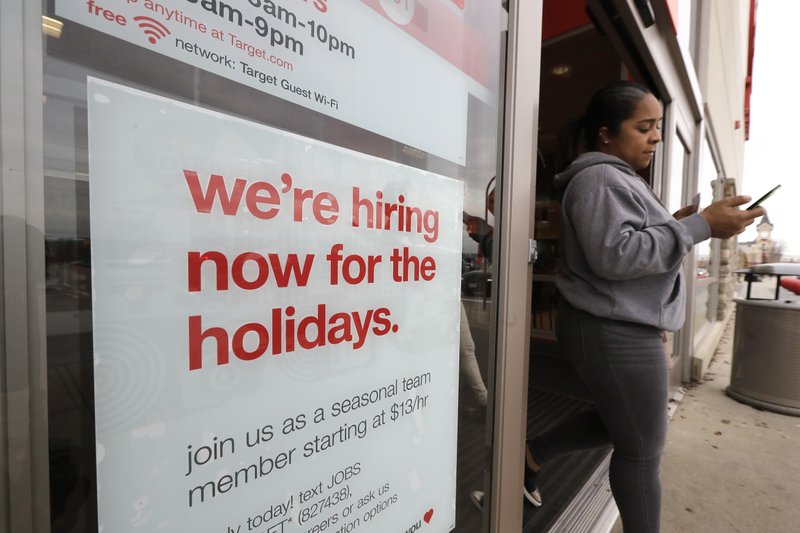WASHINGTON -- U.S. companies added just 67,000 jobs in November, a private survey found, barely half the gain of the previous month.
Payroll processor ADP said Wednesday that manufacturers, construction firms and mining companies cut 18,000 jobs combined. Companies with fewer than 20 employees also slashed their payrolls.
Employment at service providers rose by 85,000, led by gains in education and health services, while there were declines in trade, transportation, utilities and information services.
November's job gain is the lowest in six months and suggests that hiring is weakening, economists said. Yet job gains frequently fluctuate from month to month, so last month's small increase could be a one-time blip.
It typically takes roughly 100,000 or so new jobs a month to absorb population growth and keep the unemployment rate from rising. If November's modest increase were to continue, the jobless rate could rise from its currently low level of 3.6%.
The ADP data isn't affected by the General Motors workers' strike, which ended in late October and lowered hiring in the government's jobs report for October. The return of striking workers is expected to increase job gains in November's Labor Department report to be released Friday.
"The weakness in the ADP report does not guarantee a disappointment in the upcoming [government] data," said Daniel Silver, an economist at JPMorgan.
But Silver said the disappointing ADP report "is supportive of our view that the trend in job growth has downshifted lately."
ADP's figures don't include government hiring and frequently diverge from the government's official report, which is expected to show an increase of 190,000 jobs.
Hiring has been steady and resilient throughout the decade-long U.S. recovery. But job gains have slowed this year to an average of 167,000 a month, down from 223,000 last year.
Trade tensions and slowing global growth have cut into U.S. exports and caused factories to cut jobs for much of this year. Retailers, beset by online competition, have also eliminated jobs.
Still, with unemployment low and wages rising at a decent pace, consumers are still spending and driving economic growth.
ADP's payroll data represents about 411,000 firms employing nearly 24 million workers in the U.S.
A gauge of U.S. service industries fell more than forecast in November as business activity cooled, though gains in employment and new orders suggest the biggest part of the economy is holding up in the fourth quarter.
The Institute for Supply Management's non-manufacturing index fell to 53.9, according to data released Wednesday that missed the 54.5 median estimate in Bloomberg's survey of economists.
The decrease was driven by the weakest reading of business activity since 2010.
While the institute's services gauge has held for almost a decade above 50, the line between expansion and contraction, the group's manufacturing gauge has contracted for four straight months. The divergence underscores how the services sector has remained a resilient force for the record-long expansion even as factories falter.
New orders for services grew at a faster pace for a second month, lifting the index to 57.1. That helped offset the business activity gauge falling 5.4 points to 51.6.
The report indicates that trade tensions and weak global growth continue to weigh on American service providers.
A measure of order backlogs contracted for a second month, holding at the lowest level since December 2016, and the gauge of supplier deliveries eased. The prices-paid index rose to 58.5 from 56.6.
The institute's November factory report on Monday showed that the index unexpectedly declined to 48.1, near the expansion's low point, amid weaker orders and subdued production.
Information for this article was contributed by Christopher Rugaber and Martin Crutsinger of The Associated Press; and by Reade Pickert, Kristy Scheuble and Vince Golle of Bloomberg News.
A Section on 12/05/2019
